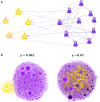Quantifying the vulnerabilities of the online public square to adversarial manipulation tactics
- PMID: 38994499
- PMCID: PMC11238850
- DOI: 10.1093/pnasnexus/pgae258
Quantifying the vulnerabilities of the online public square to adversarial manipulation tactics
Abstract
Social media, seen by some as the modern public square, is vulnerable to manipulation. By controlling inauthentic accounts impersonating humans, malicious actors can amplify disinformation within target communities. The consequences of such operations are difficult to evaluate due to the challenges posed by collecting data and carrying out ethical experiments that would influence online communities. Here we use a social media model that simulates information diffusion in an empirical network to quantify the impacts of adversarial manipulation tactics on the quality of content. We find that the presence of hub accounts, a hallmark of social media, exacerbates the vulnerabilities of online communities to manipulation. Among the explored tactics that bad actors can employ, infiltrating a community is the most likely to make low-quality content go viral. Such harm can be further compounded by inauthentic agents flooding the network with low-quality, yet appealing content, but is mitigated when bad actors focus on specific targets, such as influential or vulnerable individuals. These insights suggest countermeasures that platforms could employ to increase the resilience of social media users to manipulation.
© The Author(s) 2024. Published by Oxford University Press on behalf of National Academy of Sciences.
Figures







Similar articles
-
Coordinated inauthentic behavior: An innovative manipulation tactic to amplify COVID-19 anti-vaccine communication outreach via social media.Front Sociol. 2023 Mar 16;8:1141416. doi: 10.3389/fsoc.2023.1141416. eCollection 2023. Front Sociol. 2023. PMID: 37006634 Free PMC article. Review.
-
Understanding Malicious Accounts in Online Political Discussions: A Multilayer Network Approach.Sensors (Basel). 2021 Mar 20;21(6):2183. doi: 10.3390/s21062183. Sensors (Basel). 2021. PMID: 33804744 Free PMC article.
-
Social-Cyber Maneuvers During the COVID-19 Vaccine Initial Rollout: Content Analysis of Tweets.J Med Internet Res. 2022 Mar 7;24(3):e34040. doi: 10.2196/34040. J Med Internet Res. 2022. PMID: 35044302 Free PMC article.
-
The Spot the Troll Quiz game increases accuracy in discerning between real and inauthentic social media accounts.PNAS Nexus. 2023 Mar 22;2(4):pgad094. doi: 10.1093/pnasnexus/pgad094. eCollection 2023 Apr. PNAS Nexus. 2023. PMID: 37065618 Free PMC article.
-
Misunderstanding the harms of online misinformation.Nature. 2024 Jun;630(8015):45-53. doi: 10.1038/s41586-024-07417-w. Epub 2024 Jun 5. Nature. 2024. PMID: 38840013 Review.
References
-
- Ratkiewicz J, et al. 2011. Detecting and tracking political abuse in social media. Proceedings International AAAI Conference on Web and social media (ICWSM). 5(1):297–304.
-
- Metaxas PT, Mustafaraj E. 2012. Social media and the elections. Science. 338(6106):472–473. - PubMed
-
- Stewart LG, Arif A, Starbird K. 2018. Examining trolls and polarization with a retweet network. Proceedings ACM WSDM Workshop on Misinformation and Misbehavior Mining on the Web. 70(1):5–11.
-
- Arif A, Stewart LG, Starbird K. 2018. Acting the part: examining information operations within# BlackLivesMatter discourse. Proc ACM on Hum-Comput Interact. 2(CSCW):1–27.
-
- Lazer D, et al. 2018. The science of fake news. Science. 359(6380):1094–1096. - PubMed
LinkOut - more resources
Full Text Sources
Research Materials

